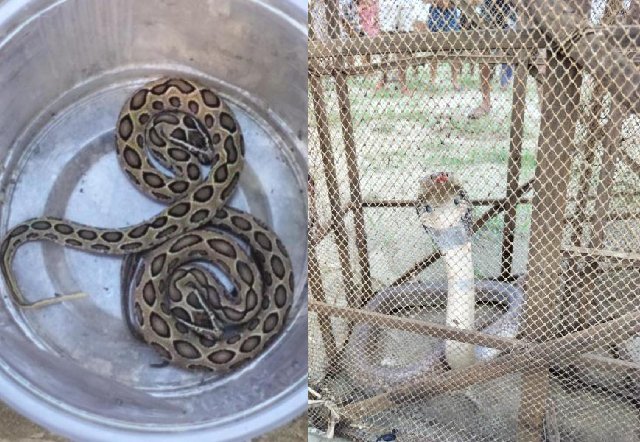More than 20 snakes, most of them venomous, have been rescued from a pocket of Howrah in the past fortnight.
The haul includes seven monocled cobras, one spectacled cobra and 10 Russell’s vipers.
Russell’s viper, Indian cobra, saw-scaled viper and Indian common krait are the four most poisonous groups of snakes, said experts.
The snakes were rescued by members of a nature lovers’ platform led by a certified snake rescuer.
The monsoon is the time when most cases of snakebites are reported across Bengal, said forest officials.
“The snakes we rescued were from different villages in Uluberia subdivision...,” said Chitrak Pramanik, a wildlife conservation enthusiast who is a trained snake rescuer, certified by the forest department.
A monocled cobra, rescued from Chandrabhag panchayat in Bagnan II Block, was almost six feet long, Pramanik said. It was spotted by locals in a water body, caught in a bamboo trap meant for fish.
The monocled cobra (Naja kaouthia) is a highly venomous snake native to South and Southeast Asia. The snakes prefer living close to water, in swamps and mangroves.
Last week, Pramanik rescued a baby Russell’s viper (Daboia russelii) from a factory near Uluberia police station. The snake was coiled under machinery.
Russell’s viper — called Chandrobora in Bengali for lunar marks all over its body — accounts for the highest number of snakebites in India.
All the snakes rescued by the team have been released back into suitable habitat, said Pramanik.
“The snakes play an important role in the general as well as agricultural ecosystem because they are natural pest controllers. Pramanik’s team is working in coordination with us. They have been instrumental in the conservation of snakes,” said a forest officer in Howrah division.
The state forest department does not have a dedicated cadre for rescuing snakes straying into human settlements. It has to depend on rescuers.
But not all of them are trained.
Many of them do it out of passion and are vulnerable to the perils of amateur rescue operations.
In November 2019, a retired man with a passion for rescuing wild animals straying into domestic settlements died after a snakebite at Naihati.
“Many of the self-trained rescuers lack proper equipment like gumboots, headlamps and snake hooks. The advent of social media has only made things worse. Untrained snake rescuers are uploading clips of so-called rescue operations. It is dangerous, to say the least,” said Anirban Chaudhuri, a herpetologist who has worked closely with the forest department on rescue and rehabilitation of reptiles and lesser mammals.
“The department headquarters has for the past few years been proactive in snake rescue operations in urban areas,” he added.










